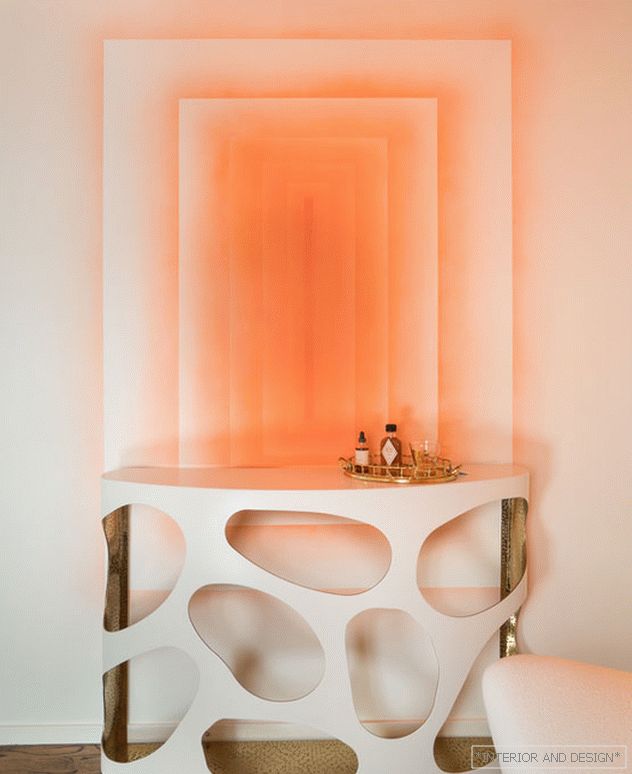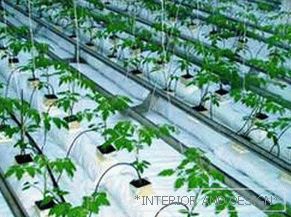 In order to grow a good crop in the conditions of private greenhouses, they organize proper fertilization in the soil and timely watering of the plants. Fertilizer plants deserve attention, because, growing greens and early vegetables, people tend to obtain better quality shoots and fruits.
In order to grow a good crop in the conditions of private greenhouses, they organize proper fertilization in the soil and timely watering of the plants. Fertilizer plants deserve attention, because, growing greens and early vegetables, people tend to obtain better quality shoots and fruits.
Wanting to grow a rich harvest, or simply not controlling the amount of chemistry, such a mass of fertilizers is added to the ground that greenhouse products cannot be considered environmentally friendly. In order to avoid misunderstanding in practice, a drip irrigation system is used for greenhouses, which is able to prevent plants from over-feeding with chemicals.
Content
- 1 Essence of drip irrigation
- 1.1 Installation of droppers
- 2 Types of drip irrigation
- 2.1 Feed system for individual droppers
- 2.2 Watering system using drip tape
- 3 Pros of use in the greenhouse drip irrigation
- 4 Watering device in the greenhouse
- 4.1 System installation
- 5 Prevention for longer life
Essence of drip irrigation
Micro-irrigation allows you to apply moisture to the roots of the plant in the right quantity, while saving water. Using this method of irrigation, the owners of greenhouses significantly reduce the cost of growing crops. When drip wetting water enters the soil in the form of jets or drops, in the diameter of components from 1 to 2 mm. The moistening of the earth is obtained due to the action of capillary directions, while the yoke is fed in a horizontal and vertical direction.
An important component of the system are droppers that are installed on the main water pipe and supply moisture to the roots of seedlings. There are many types of droppers supplied with various devices for effective work. An example would be the controllers of water pressure in the general water supply network and devices for dosed discharge of water.
Under droppers in the topsoil a wet zone is created, which becomes more after moisture gets into the deep earth. Different types of crops, planted in the ground with different characteristics, require the installation of a certain number of droppers, and the frequency of planting adjusts the distance between the mini-irrigation tubes.
Installation of droppers
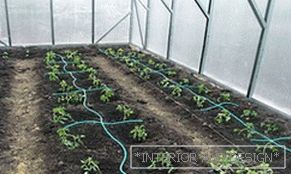 It is not difficult to arrange drip irrigation with your own hands, any greenhouse worker will cope with this. The diameter of the main pipe is 15–20 mm, and droppers with a diameter of up to 2 mm are strengthened on its surface. To reduce the rate of water supply to the soil, the main pipe is made in the form of a spiral, whose length is inversely proportional to the power of the water flow. Systems by location are divided:
It is not difficult to arrange drip irrigation with your own hands, any greenhouse worker will cope with this. The diameter of the main pipe is 15–20 mm, and droppers with a diameter of up to 2 mm are strengthened on its surface. To reduce the rate of water supply to the soil, the main pipe is made in the form of a spiral, whose length is inversely proportional to the power of the water flow. Systems by location are divided:
- above ground, located above the ground, feeding water directly to the top of the ground;
- underground, in which water outlets with the help of branches of the feeding tube enter the surface from a depth of 40–45 cm.
Have drip irrigation there are disadvantages:
- the presence in the water of salt and other impurities contributes to the rapid clogging of the drip assembly, to reduce this phenomenon, apply the method of settling irrigation water and install the filter in the form of a grid at the beginning of the system;
- there is a need to regulate the uniform flow of moisture in each drip separately for the length of the entire main pipeline.
Drip irrigation system satisfied with the help of porous humidifiers. With the help of dosed moisture in the soil, the soil is fertilized with the necessary amount of mineral substances and salts. To do this, the system is embedded fertilizer feeder into the system:
- injection method, in which the supply of fertilizers into the main pipe is carried out by a metering pump;
- ejection, when at the point of connection of the tank with fertilizers creates a significant drop in water pressure.
To implement fertilization by dissolving in water, the presence of mineral substances in the moisture itself and their interaction with dressings is taken into account. An example is the deposition of significant sediment on the walls of the pipe after the interaction of hard water with phosphate fertilizers.
Types of drip irrigation
For the implementation of the supply of moisture to the basal system used various methods of watering in greenhouses:
- installation of separate droppers for each plant;
- Use to supply moisture drip tape.
Feed system for individual droppers
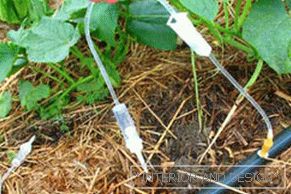 Droppers act as the main elements of the irrigation system, irrigation work in general depends on their choice. Droppers sell with the regulation of the supply of moisture and without regulation. Using the feed control set head from 3 to 25 liters per hour. Improving the efficiency contributes to the installation of compensatory adjustable droppers, which are able to maintain the pressure of moisture, regardless of the speed of the jet in the water supply.
Droppers act as the main elements of the irrigation system, irrigation work in general depends on their choice. Droppers sell with the regulation of the supply of moisture and without regulation. Using the feed control set head from 3 to 25 liters per hour. Improving the efficiency contributes to the installation of compensatory adjustable droppers, which are able to maintain the pressure of moisture, regardless of the speed of the jet in the water supply.
With the help of microtubes (plastic tubes, mounted on the nozzle), the water is discharged to the desired point for irrigation. Connecting valves are used to assemble all elements into a single system: fittings, expansion joints, tees, fittings, pressure compensation devices, valves and taps. Installing the latter allows you to include or remove from the system areas of the greenhouse, which are subject to irrigation and fertilizer.
Branches, commonly called "spiders", contribute to the branching of several fittings from the point of attachment of one dropper. The ends of the tubes to establish at the desired point of irrigation greenhouses attached to the racks. The distribution pipes are connected to the main pipeline with the help of start-connectors, which are attached to the pipeline through drilled holes in the supply pipe. To create a sealing torque on the start-connector is clamping nut.
Be sure to provide for the installation of a water filter in the watering system of the greenhouse. You should not hope that the water in the system is clean enough and the presence of a filter will not change anything. This attitude leads to the fact that due to small dirt or pieces of rust the microscopic opening of one of the droppers clogs and moisture does not flow to the desired plant.
To choose the filter capacity correctly, count the number of droppers in the greenhouse over the entire length of the pipe, then multiply it by the microtubing pass capacity in liters and get the required filter bandwidth. The described drip irrigation system is durable and reliable. Having put such irrigation in the greenhouse, the owner of the greenhouse for 12 years will forget about the problems of irrigation and drip fertilizer.
Watering system using drip tape
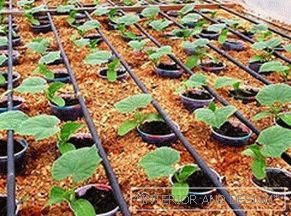 This system is less durable in operation than the previous one, it is easier to install. It is a tube with holes on the walls for moisture release. The distance between them is assumed to be standard - 100, 30 and 20 cm. Tapes are attached to the main pipe with the help of a start-connector, the second end of the tape is plugged with a stopper, and water is released from the holes when moisture is released.
This system is less durable in operation than the previous one, it is easier to install. It is a tube with holes on the walls for moisture release. The distance between them is assumed to be standard - 100, 30 and 20 cm. Tapes are attached to the main pipe with the help of a start-connector, the second end of the tape is plugged with a stopper, and water is released from the holes when moisture is released.
The positive aspects of such a device include low cost due to the exclusion of a large number of connecting fittings and ease of installation in the greenhouse. But drip irrigation system does not serve more than three years. Its thin walls can be spoiled by the teeth of pests, for example, a bear or other inhabitants of the soil in the greenhouse. Drip tapes do not regulate the mass of water supplied to the plant and cannot transfer moisture directed to a certain place of the bed in the greenhouse.
Advantages of use in the greenhouse drip irrigation
Having installed an irrigation system in a greenhouse or greenhouse, the owner will not spend money in vain, as it will have many advantages:
- economical use of water resources;
- uniform moisture supply to all plants in the area of the root system and gradual saturation of the plant with water and nutrient fertilizers;
- soil moisture microclimate remains constant, the earth is not overdried.
- soil erosion does not occur and, as a result, the root system is exposed;
- the drip system protects the plant from weeds and diseases; in the ordinary way, water gets on the leaves of plants, which in the heat causes additional diseases;
- it is possible to control the growth of crops by reducing irrigation or adding minerals to the moisture supply;
- reduction of labor costs for the physical maintenance of watering inside the greenhouse, no need to carry water and water the beds;
- increasing greenhouse productivity and increasing yield;
- the ability to control the microclimate in the greenhouse and soil moisture, which will lead to the preservation of plants during the frost period.
Watering device in the greenhouse
First, you should decide on the type of drip irrigation, and only then proceed to the collection of all components. In the standard system contains the following components:
-
 disk filter;
disk filter; - drip tape;
- connectors for hoses and fittings;
- start connectors with taps and seals;
- start connectors without cranes with seals;
- repair kit for branching and fittings.
System installation
The construction of a watering system in a greenhouse will require thin PVC pipes of up to 20 mm in diameter. It should be opaque and dark in color. This is a necessary condition for the impossibility of the development of microorganisms and bacteria in it. For a watering device, just a few pieces pipes up to 7 m.
As nozzles used elements of medical droppers, the internal diameter of which is up to 2 mm. Their number is calculated by the number of seedlings. Nozzles of small diameter are fixed to the main pipeline. You can buy in the store ready-made drip tape for watering in greenhouses.
The best choice is a tube with a wall thickness of 200 microns, and its inner diameter is 16 mm. Attached to it at regular intervals dropper, which have, depending on the type of plant. For example, cucumbers are placed after 15 cm, therefore droppers are attached through the same distance.
For tomatoes, the period of attachment is increased to 30 cm. Drip irrigation with such parameters skips about 1 liter of water per hour and moistens the earth in a radius of approximately 20–25 cm. It is very easy to assemble a watering drip system in a greenhouse with your own hands.
The fittings used are fittings in the form of a short gap in a plastic tube with a nut, thread and gasket. Sometimes the device is equipped with a separate valve to regulate the flow of water to plants with different needs. In addition to these connectors, use for mounting plugs, seals, connecting clamps, elbows, turns at different angles and other standard elements of the system.
To attach the droppers to the main pipe, drill holes in the pipeline, then put a sealing rubber ring and fitting element in it in the proposed sequence. On a horizontally laid pipe, all fittings are mounted in the same plane, then watering tapes are fastened to them with the help of threads and nuts.
As a source of water supply in the greenhouse, any container with a tap, raised and secured, is used. at a height of 3m. Ideal for watering in a greenhouse is water from a well. Do not use chlorinated tap water or liquid from natural rivers and lakes. In the case of the latter option, microorganisms, once in a favorable greenhouse environment, will begin active reproduction.
Installing the filter is expensive, so the owner has the right to decide to clean the water in the system for him or to spend money each year to replace the use of droppers and connecting elements.
Prevention for longer life
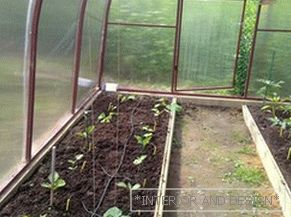 For a drip irrigation system to serve for a long time, it is enough to organize preventive care for removable irrigation elements. This, in particular, concerns the replacement of the filter element in the tank. The seemingly clean water at first glance may have microscopic pollutants that cannot be distinguished with the naked eye, but such small elements can cause much trouble to the greenhouse owner.
For a drip irrigation system to serve for a long time, it is enough to organize preventive care for removable irrigation elements. This, in particular, concerns the replacement of the filter element in the tank. The seemingly clean water at first glance may have microscopic pollutants that cannot be distinguished with the naked eye, but such small elements can cause much trouble to the greenhouse owner.
If an obstruction is detected in one of the droppers, it should be promptly cleaned and continued to use, this will affect the growth of the crop that is irrigated by this section of the tape. In winter, in areas with severe frosty conditions, it is necessary to dismantle the entire system for the winter so that it is not damaged by low temperatures.

